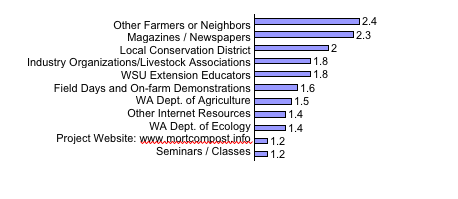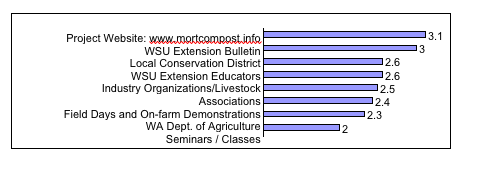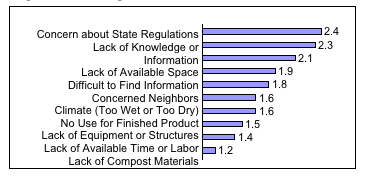 |
December 2009
|
December 2009 // Volume 47 // Number 6 // Research In Brief // v47-6rb8
On-Farm Mortality Composting in Washington State: Outreach and Producer Survey
Abstract
The WSU On-Farm Mortality Composting Project of the Biologically Intensive and Organic Agriculture (BIOAg) Program demonstrated on-farm mortality composting as an effective disposal option for routine livestock mortalities. To evaluate the impacts of the project and determine the direction of future research and outreach, Washington dairy producers currently composting farm mortalities were surveyed. Their most important sources of initial information about mortality composting were other farmers and neighbors, magazines and newspapers, and local conservation districts. Future information was preferred from a Web site and university Extension bulletin, not classes or seminars. Composting reduced mortality disposal costs for 92% of these operations.
Introduction
Even under the best management, livestock die on the farm. The routine loss of small numbers of livestock from illness or injury can add up to significant financial loss for producers. The disposal of a carcass adds cost and inconvenience for a producer who has lost a valuable animal.
As a result of the bovine spongiform encephalopathy, aka "mad cow disease" scare of 1994, there has been a dramatic reduction in both the number of carcass-rendering facilities and demand for rendering products (proteins, oils, fats, etc.) over the last decade (Petrak, 2007). Because the sale of these products previously subsidized rendering costs, the cost to farmers for rendering has increased substantially. In many areas, the frequency of pick-up has also decreased significantly, requiring a wait of several days for carcass removal. On-farm burial or natural decomposition on rangeland is legal in some areas. While less costly than rendering, this may attract pests, contaminate ground and surface water, challenge neighbor relations, and may only be practical during certain times of the year. Given the costs and challenges of traditional disposal options, many livestock producers in Washington State are seeking alternatives.
With proper management and materials, on-farm composting can be an economically viable and environmentally sound method of mortality disposal and in many cases provides a much-needed alternative for producers. A recent report by the USDA-APHIS showed that nationwide between 2002 and 2007 the percentage of dairy cow mortalities disposed of by burial and rendering decreased from 85% to 77%, while the percentage of mortalities disposed of by composting increased from 7% to 17% (USDA, 2008).
In Washington State, three regulatory agencies have overlapping authority over on-farm mortality composting. Recent changes to rules on carcass disposal by both the Washington State Department of Agriculture (WSDA) and the Washington State Department of Health, as well as publication of state guidelines for mortality composting by the Washington State Department of Ecology (WSDOE, 2005), have led to increased interest in the practice by both producers and regulators. To address this interest, Washington State University (WSU) developed a demonstration and education program targeted at dairy and beef producers.
The WSU On-Farm Mortality Composting Project was a collaborative effort between the WSU Biologically Intensive and Organic Agriculture (BIOAg) Program, WSDOE, and WSDA. Our goal was to demonstrate and promote on-farm mortality composting as a legal and effective disposal option for routine bovine mortalities in Washington State. The project consisted of three phases.
Phase I: Demonstration of mortality composting methods. Primary objectives:
- Collaborate with producers and state and county Extension specialists to establish and monitor trial sites.
- Identify appropriate compost methods based on region, materials, and farm size.
Phase II: Development and use of educational resources based on information and experience gained from the field trials. Primary objectives:
- Create an informational Web site as a resource for producers, industry representatives, and educators.
- Provide information about on-farm mortality composting through industry events, classes, and publications.
- Publish a WSU Extension bulletin about mortality composting.
Phase III: Evaluation of experiences and information used by mortality composters in Washington. Primary objectives:
- Identify the preferred sources of information about mortality composting, primary challenges and motivations for producer adoption, compost methods, and on-farm impacts for Washington dairy farmers composting farm mortalities.
- Evaluate the need for future work on this topic.
This article presents the findings of Phase III, gathered through a survey of dairy producers currently composting farm mortalities in Washington State. The results were a valuable tool for evaluating the success of the project and for determining the direction of future education efforts.
Data and Methods
Through an extensive search and statewide contacts, 18 Washington dairy producers were identified that currently compost livestock mortality. Dairies were targeted for this survey because the interest and adoption rate for mortality composting on dairies is greater than for other large-animal operations. Unlike many feedlot operations, dairies tend to have both the necessary co-composting materials and sufficient land base to use the finished compost. All 18 current composters were contacted by phone to explain the project and solicit their participation in the survey. One producer declined to participate; questionnaires and cover letters were mailed to the remaining 17 producers.
The survey consisted of 27 questions divided into six sections: general information, sources and availability of information, methods and materials, motivations and challenges, and impacts. Participants were contacted by phone up to two times to encourage survey completion; 13 surveys were returned (76% response rate).
Results
General Information
The 18 dairies identified as currently composting livestock mortalities represent 3.6% of Washington's 496 dairies (DFW, 2008). Table 1 shows the distribution of survey respondents by farm acreage and number of milking cows. Farm acreage owned and/or leased by respondents ranged from 55 to 2,200 acres, with a mean of 685 acres. Nearly half of the operations were less than 500 acres. Milking cows per operation ranged from 390 to 3,600 cows, with a mean of 1,377 cows. This is nearly three times the state average of 480 cows (DFW, 2008). Two operations were Certified Organic or in transition to Certified Organic.
| Percentage of Producers | |
| Acres Leased or Owned | |
| 50 to 500 | 46 |
| 501 to 1000 | 31 |
| More than 1000 | 23 |
| Number of Milking Cows | |
| 300 to 700 | 46 |
| 701 to 1500 | 23 |
| 1501 to 3000 | 23 |
| More than 3000 | 8 |
Sources and Availability of Information
Producers were asked to indicate the level of importance of eleven different sources of information that they may have used when they first started composting mortalities. Other farmers and magazines/newspapers were identified as the two most important information sources, while the project Web site <http://www.mortcompost.info> and seminars/classes were identified as the least important (Figure 1). All respondents reported having access to the Internet at their home or farm.
Figure 1.
Importance Attributed to Sources of Information about Mortality Composting for Producers Beginning to Compost. Mean Score on a Scale from 1 (Not Important) to 4 (Very Important). N = 13.
A large majority (77%) of surveyed producers indicated they did not currently have all of the information they needed about mortality composting (data not shown). These producers were then asked to identify sources of additional information they would most prefer. The project Web site <http://www.mortcompost.info> and a WSU Extension bulletin were most preferred, while seminars/classes were least preferred (Figure 2).
Figure 2.
Preferences of Dairy Producers for Sources of Further Information about Mortality Composting. Mean Score on a Scale from 1 (Least Preferred) to 4 (Most Preferred). N = 13.
Compost Methods and Materials
The most common compost system used by respondents was windrows, followed by single piles (Table 2). Most producers did not have covered compost areas. Two-thirds of producers were composting both cows and calves; the remainder were composting only calves. Nearly all producers (92%) measured compost temperatures only when there was a problem, or not at all. The majority of producers composting full-sized cows reported that the entire process took 4 to 8 months, which is typical for a well-managed system. All producers reported that the finished compost was applied to cropland or pasture that they own or manage, and a few reported other uses as well.
| Percentage of Producers | |
| Type of Compost System | |
| Windrows | 50 |
| Single piles | 25 |
| 3-sided bins | 8 |
| Compost shed | 17 |
| Types of Mortalities Composted | |
| Calves only (50-100 lbs) | 33 |
| Calves and cows (1200-1500 lbs) | 67 |
| Frequency of Compost Temperature Measurements | |
| At least once per week | 0 |
| 1 to 2 times per month | 8 |
| Only when concerned there is a problem | 50 |
| Never | 42 |
| Length of Compost Process from Start to Finish | |
| 2 to 4 months a | 33 |
| 4 to 8 months | 50 |
| 8 to 12 months | 17 |
| Primary Use of Finished Product | |
| Applied on-farm to pasture/crop land | 100 |
| Other b | 33 |
| a Producers reporting 2 to 4 months from start to finish are composting calves only. b Other uses include bedding, flower beds, and transport off-farm. Some producers identified more than one primary use. |
|
Motivations and Challenges
Reduced disposal cost and immediate year-round disposal were the most common primary motivations for composting farm mortalities (Table 3). Nearly 90% of survey respondents selected one or both of these as primary motivations. No respondents selected environmental concerns and on-farm nutrient cycling as primary reasons for mortality composting.
| Primary Motivation | Percentage of Producers |
| Reduce disposal costs | 46 |
| Reduce disposal costs AND Immediate year-around disposal a | 31 |
| Immediate year-around disposal | 15 |
| Lack of local rendering services | 8 |
| Environmental/water quality concerns | 0 |
| On-farm nutrient cycling | 0 |
| a Respondents were asked to select one primary motivation from a list of five options, but four respondents identified both "Reduce disposal costs" and "Immediate year-around disposal" as primary motivations. | |
Producers were asked to rate the degree of challenge they associated with 10 different factors when adopting on-farm mortality composting. Concern about state regulations and lack of information ranked highest as challenges, while lack of equipment, time, and materials ranked lowest (Figure 3). No factor was rated above 2.4 on average.
Figure 3.
Degree of Challenge Attributed to Ten Factors Associated with On-Farm Mortality Composting. Mean Score on a Scale from 1 (Not at All) to 4 (Considerable) N = 13 
Impacts
When asked to identify changes in the costs associated with on-farm mortality composting compared to other disposal methods, all producers except one reported that disposal costs decreased with composting. Two-thirds of producers reported no significant increase in labor associated with disposal since they began composting mortalities, while the remaining one-third reported an increase in labor (Table 4).
| Percentage of Producers | |
| Impact of Composting on Cost of Carcass Disposal | |
| Disposal costs have decreased | 92 |
| Disposal costs have increased | 0 |
| No significant difference | 8 |
| Impact of Composting on Labor of Carcass Disposal | |
| Amount of labor has decreased | 0 |
| Amount of labor has increased | 33 |
| No significant difference | 67 |
Discussion
The survey results provide valuable information about the needs of dairy producers currently composting farm mortalities in Washington State. The results allow for evaluation of the success and impacts of the WSU On-Farm Mortality Composting Project, as well as for the development of future research and Extension projects on this topic.
Starting an on-farm mortality composting operation can be appealing but problematic. The availability and reliability of information may determine whether a given operation tries or balks, succeeds, or fails. For the surveyed producers, the most important initial sources of information were other farmers and magazines/newspapers. These results suggest that word-of-mouth and print media are important sources of information, possibly because they can lend credibility to a new practice that may be seen as risky.
The project Web site <http://www.mortcompost.info/> and seminars/classes were identified as the least important initial sources of information (Figure 1). Yet producers in need of more information preferred to use the project's Web site and a WSU Extension bulletin (Figure 2). At the time of this survey, the project Web site had been active approximately 12 months and was not available at the time most survey respondents had started mortality composting. Because the Web site and a WSU Extension bulletin (Price & Carpenter-Boggs, 2008) were recently developed, future work should aim to make these preferred resources widely available and to train agricultural professionals. The various human resources such as WSU Extension, Conservation Districts, and livestock or industry associations are significant suppliers of information and should be well prepared to work with producers interested in mortality composting.
The primary motivations for composting were reduced cost and convenience (Table 3). It appears those goals were fulfilled by adoption of mortality composting. Twelve of the 13 producers reported that their carcass disposal costs decreased with composting, and two-thirds of producers reported no significant increase in labor (Table 4). Comments on the returned surveys included "For the very small amount of effort it takes we saw significant financial savings—no real negatives" and "Nice compost—shouldn't take much time." Using the finished compost as a soil amendment keeps valuable nutrients on the farm and improves soil quality, providing additional benefits beyond lowering costs. Although nutrient recycling was not a primary motivation for any of the respondents, all are using the finished compost on land they own or manage, and some are also using it in flowerbeds or giving it away.
Overall, there were no considerable challenges in getting started in mortality composting for most producers surveyed. The two primary challenges were concern about state regulations and lack of information (Figure 3), both of which have been recently addressed by clarified and coordinated rules from Washington's regulatory agencies and through this project. Developing the compost site, acquiring equipment or compost materials, and using the finished product were not significant challenges for most producers. Therefore, these likely would not be effective foci for future work.
The guidelines established by WSDOE (which are similar to those for other states) and promoted throughout this project recommend measuring internal compost temperatures at least once per week to ensure proper conditions for pathogen reduction (WSDOE, 2005). Pathogen reduction in compost is primarily a factor of high temperatures (Haug, 1993). Our survey results show that the majority of producers rarely or never measure compost temperatures (Table 2). Presumably these producers are not greatly concerned about pathogen contamination and prefer a low-maintenance management system. However, this finding will be disconcerting to regulators and many others. Continued and improved regulatory support of on-farm mortality composting will require serious attention to the safety of the process by producers; therefore regular temperature monitoring must be strongly encouraged.
For producers interested in composting farm mortalities or educators interested in promoting the practice in other states, it is first important to know current state regulations and the degree of support from regulatory agencies. The support of state regulatory agencies was crucial to the success of the WSU project and we hope other states will be able to repeat this collaboration and success.
The positive feedback received throughout this project and the results of this survey show that both producers and regulators are appreciative of this safe and effective carcass disposal alternative. As the practice of composting large carcasses on the farm gains in both popularity and credibility, and more people see how effective and efficient it can be, mortality composting will undoubtedly become a common practice on farms around Washington State and beyond.
References
Dairy Federation of Washington (DFW). (2008). Facts about the Washington dairy industry. Retrieved July 22, 2008 from: http://www.havemilk.com/article.asp?id=2142
Haug, R. T. (1993). The practical handbook of compost engineering. Lewis Publishers, Boca Raton, FL.
Petrak, L. (2007). Amazing transformations. The National Provisioner, 221, 80.
Price, C., & Carpenter-Boggs, L. (2008). On-farm composting of large animal mortalities. WSU Extension Bulletin #EB2031E. Pullman, WA.
United States Department of Agriculture (USDA). (2008). Dairy 2007. Part II: Changes in the U.S. dairy cattle industry, 1991-2007. #N481.0308. USDA-APHIS-VS, CEAH. Fort Collins, CO.
Washington State Department of Ecology (WSDOE). (2005). On-farm mortality composting of livestock mortalities. Pub. #05-07-034. Retrieved July 22, 2008 from: http://www.ecy.wa.gov/biblio/0507034.html




